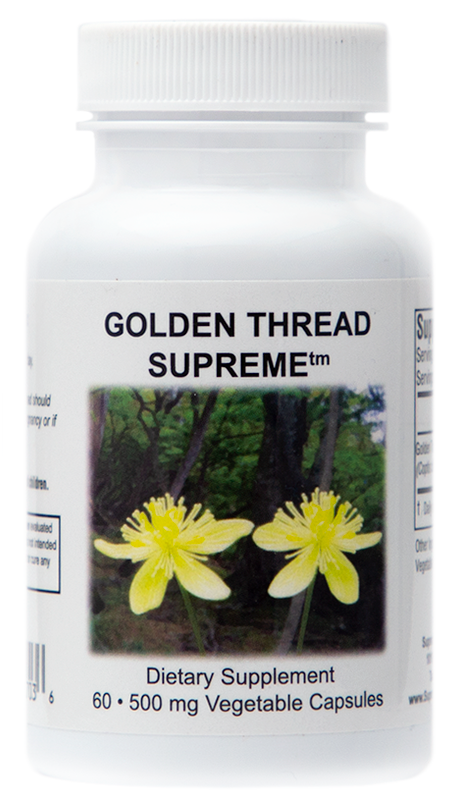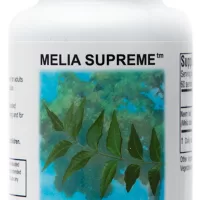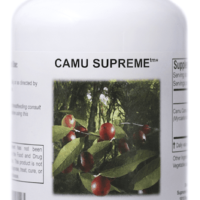Description
Golden Thread Supreme™ is the powdered rhizome of the plant Coptis chinensis. This herb has been used in traditional Chinese medicine for over two thousand years. It contains a number of alkaloids that have been subject to recent research. The most well known of these alkaloids is berberine, the component that gives goldenseal, coptis, and oregon grape root their yellow/gold color, bitter taste and some of their therapeutic effect. Coptis chinensis contains 5-7% berberine as well as other important therapeutic compounds such as coptisine [1].
Much of the following information has been gleaned from textbooks translated from the Chinese. Golden Thread has been used extensively in the treatment of gastrointestinal disorders that are of a pathogenic origin [2]. It has proven to be an effective antifungal [3], antibacterial (including staph aureus, h.pylorii, strep pneumonia, tuberculosis, shigella, pseudomonas, salmonella, and many gram positive bacteria and micobacterium) [4, 5, 6, 7, 8], antiparasitic [9, 10, 11] (including leptospirosis, trichomonas, amoeba, giardia), antiBiofilm [12] and antiviral [13] (including influenza and Newcastle virus) herb. It is also reported to have antiradiation effects [14]. In a situation where you have an “over facilitated sympathetic nervous system” berberine in Coptis has been shown to be helpful. It can also increase bile production and is used in the Orient in cases of chronic gall bladder problems, cold sores, and to help slow the development of atherosclerosis [15, 16].
In a fairly recent study, a decoction of Coptis (Golden Thread) was used as an enema in the treatment of ulcerative colitis on several patients with excellent results, as well as in controlled studies on mice with ulcerative colitis [17].
In China it has been used to treat infantile dysentery, Trichomoniasis, diphtheria, scarlet fever, tuberculosis, typhoid fever, tonsillitis, eczema, type II diabetes and ventricular extra systole [18, 19, 20].
I have used Coptis (Golden Thread) for 15 years and have found it to be another great antimicrobial as effective as Melia and Morinda. I used to use it in tincture form but stopped years ago as I find the capsules do not stress the liver like the alcohol in the tincture might and it appears to reach further down in the gastrointestinal tract (as a capsule) and in general to be more effective. I find sometimes one or sometimes more of these aforementioned antimicrobials are needed for the patient. There are times when Coptis will work when Morinda and Melia do not. Between the three of them, they should cover a wide range of conditions.
Most of the research being done currently on Coptis (Golden Thread) is being conducted on laboratory mice or other animals. Nevertheless, the results show the potential usefulness of Coptis in a number of areas. Besides confirming the traditional uses of Coptis, the research indicates that it is hepatoprotective [21] probably due to antioxidant properties, and can lower blood sugar and blood cholesterol levels [22, 23]. In one study the effects of several Coptis alkaloids were examined on the inhibition of cholinesterases and beta amyloids [24]. The results of this study indicated that “…coptidis rhizoma alkaloids have a strong potential of inhibition and prevention of Alzheimer’s disease…”. It also acts as a monoamine oxidase inhibitor and thus can potentially be used as an anti-depressant [25].
In one study taking coptis worked as well as Clotrimazole against vulvovaginal candidiasis, but the recurrence rate was 66% less when taking coptis, making it a better option [26]. It also works as an anti-microbial against Brucella abortus and against H. Pylori in addition to repairing the stomach [27, 28]. New research shows it also reduces the pain in those suffering from IBS by decreasing CCK and serotonin release in the distal colon [29].
As you can see, like most of our products it has many, many possible uses, and should be checked with every patient.
Dosage
The recommended dosage is 1 cap 3x/day. Even though I have not read of contraindications in young children, I only prescribe it when they are old enough to swallow the capsule (it is very bitter if taken out and hard to swallow). Golden Thread is a potent herb and should not be used during pregnancy or nursing. It also may interfere with the absorption of tetracycline.
Citations:
1. Sato, Fumihiko, and Yasuyuki Yamada. “High Berberine-producing Cultures of Coptis Japonica Cells.” Phytochemistry 23.2 (1984): 281-85. Web.
2. Yan, Dan, Li Wei, Xiaohe Xiao, Danlei Zhou, and Yumei Han. “Microcalorimetric Investigation of Effect of Berberine Alkaloids from Coptis Chinensis Franch on Intestinal Diagnostic Flora Growth.” Chin. Sci. Bull. Chinese Science Bulletin 54.3 (2009): 369-73. Web.
3. YU, Jun, Xue-jin SU, and Li WANG. “Antifungal Effects of Eight Kinds of Traditional Chinese Medicine in Vitro.” Academic Journal of PLA Postgraduate Medical School (2007): n. pag. Web. 10 June 2015.
4. Chang, N. C. “In Vitro Antibacterial Action of Extracts from Coptis Root.”Experimental Biology and Medicine 69.1 (1948): 141-43. Web.
5. Wang, V.F.L. “In Vitro Antibacterial Activity of Some Common Chinese Herbs on Myeobacteria Tuberculosis.” Chinese Medical Journal 68.5-6 (1950): 169-72. Web.
6. Yang, Yong, Zhi-ying Li, Fang-Ping Wu, and Gang Huang. “The Advance on Antimicrobial Effect of Berberine.” Progress in Modern Biomedicine(2009): n. pag. Web.
7. Zeng, Li-Ping, and Xiu-qin Cui. “Combined Antibacterial Activity of Three Chinese Drugs Against Helicobacter Pylori.” 《Journal of Chengdu Medical College (2008): n. pag. Web.
8. Vuddanda, Parameswara Rao, Subhashis Chakraborty, and Sanjay Singh. “Berberine: A Potential Phytochemical with Multispectrum Therapeutic Activities.” Expert Opin. Investig. Drugs Expert Opinion on Investigational Drugs 19.10 (2010): 1297-307. Web.
9. Kaneda Y, Torii M, Tanaka T, et al. In vitro effects of berberine sulphate on the growth and structure of Entamoeba histolytica, Giardia lamblia and Trichomonas vaginalis. Annals Trop Med Parasitology 1991;85(4):417-25.
10. Rabbani GH, Butler T, Knight J, et al. Randomized controlled trial of berberine sulfate therapy for diarrhea due to enterotoxigenic Eschericia coli and Vibrio cholerae. J Infec Dis 1987;155(5):979-84.
11. Kaneda, Y., T. Tanaka, and T. Saw. “Effects of Berberine, a Plant Alkaloid, on the Growth of Anaerobic Protozoa in Axenic Culture.” The Tokai Journal of Experimental and Clinical Medicine 15.6 (1990): 417-23. Web.
12. Chen, Li, and Yu‐Mei Wen. “The Role of Bacterial Biofilm in Persistent Infections and Control Strategies.” International Journal of Oral Science Int J Oral Sci 3.2 (2011): 66-73. Web.
13. Kurokawa, Masahiko, Haruo Ohyama, Toyoharu Hozumi, Tsuneo Namba, Michio Nakano, and Kimiyasu Shiraki. “Assay for Antiviral Activity of Herbal Extracts Using Their Absorbed Sera.” Chem. Pharm. Bull. CHEMICAL & PHARMACEUTICAL BULLETIN 44.6 (1996): 1270-272. Web.
14. Wang, Xi-Jing, Shuai Lin, Hua-Feng Kang, Zhi-Jun Dai, Ming-Hua Bai, Xiu-Long Ma, Xiao-Bin Ma, Meng-Jie Liu, Xiao-Xu Liu, and Bao-Feng Wang. “The Effect of RHIZOMA COPTIDIS and COPTIS CHINENSIS Aqueous Extract on Radiation-induced Skin Injury in a Rat Model.” BMC Complement Altern Med BMC Complementary and Alternative Medicine 13.1 (2013): 105. Web.
15. Tang, W., and Gerhard Eisenbrand. “Coptis Spp.” Chinese Drugs of Plant Origin: Chemistry, Pharmacology, and Use in Traditional and Modern Medicine. Berlin: Springer-Verlag, 1992. 361-71. Print.
16. Wu, Min, Jie Wang, and Long-Tao Liu. “Advance of Studies on Anti-atherosclerosis Mechanism of Berberine.” Chinese Journal of Integrative Medicine Chin. J. Integr. Med. 16.2 (2010): 188-92. Web.
17. Zhou, H. & S. Mineshita: The effect of berberine chloride on experimental colitis in rats in vivo and in vitro. J. Pharmacol. Exp. Therap.2000, 294, 822–829.
18. Yan, Dan, Cheng Jin, Xiao-He Xiao, and Xiao-Ping Dong. “Antimicrobial Properties of Berberines Alkaloids in Coptis Chinensis Franch by Microcalorimetry.” Journal of Biochemical and Biophysical Methods70.6 (2008): 845-49. Web.
19. Riddell, William Renwick, and Samuel B. Emmons. “The Pharmacopoeia of Another Botanical Physician.” (1919): n. pag. Web.
20. Zeng, Xiangji. “HPLC Determination of Berberine in Plasma of Patients with Ischemic Heart Failure.” Chromatographia 48.7-8 (1998): 589-90. Web.
21. Ye, Xingshen, Yibin Feng, Yao Tong, Kwan-Ming Ng, Saiwah Tsao, George K.k. Lau, Chowing Sze, Yanbo Zhang, Jun Tang, Jiangang Shen, and Seiichi Kobayashi. “Hepatoprotective Effects of Coptidis Rhizoma Aqueous Extract on Carbon Tetrachloride-induced Acute Liver Hepatotoxicity in Rats.” Journal of Ethnopharmacology 124.1 (2009): 130-36. Web.
22. Zhen, Zhong, Bai Chang, Min Li, Feng-Mei Lian, Liang Chen, Liu Dong, Jia Wang, Bo Yu, Wen-Ke Liu, Xiu-Yang Li, Pei-Jie Qin, Jing-Hua Zhang, and Xiao-Lin Tong. “Anti-Diabetic Effects of a Coptis Chinensis Containing New Traditional Chinese Medicine Formula in Type 2 Diabetic Rats.”The American Journal of Chinese Medicine Am. J. Chin. Med. 39.01 (2011): 53-63. Web.
23. Yuan, Lujiang, Dawei Tu, Xiaoli Ye, and Jianping Wu. “Hypoglycemic and Hypocholesterolemic Effects of Coptis Chinensis Franch Inflorescence.” Plant Foods Hum Nutr Plant Foods for Human Nutrition 61.3 (2006): 139-44. Web.
24. Durairajan, Siva Sundara Kumar, Liang-Feng Liu, Jia-Hong Lu, Lei-Lei Chen, Qiuju Yuan, Sookja K. Chung, Ling Huang, Xing-Shu Li, Jian-Dong Huang, and Min Li. “Berberine Ameliorates β-amyloid Pathology, Gliosis, and Cognitive Impairment in an Alzheimer’s Disease Transgenic Mouse Model.” Neurobiology of Aging 33.12 (2012): 2903-919. Web.
25. Kong, Ling Dong, Christopher H.k. Cheng, and Ren Xiang Tan. “Monoamine Oxidase Inhibitors from Rhizoma of Coptis Chinensis.”Planta Med Planta Medica 67.1 (2001): 74-76. Web.
26. Yang, Yi, Rui-lan Li, Yu-mei Ning, Hui-jun Ye, Ji-wen Yu, and Lei Zhao. “Curative Effect of Single Coptis Chinensis Decoftion on Treatment of 81 Cases of Vulvovaginal Candidiasis.” Chinese Journal of Nosocomiology (2013): n. pag. Web.
27. Kim, Dae Geun, Hannah Leah Tadeja Simborio, Alisha Wehdnesday Bernardo Reyes, Wongi Min, Hu Jang Lee, Jin Ju Lee, Hong Hee Chang, Dong Hyeok Kim, and Suk Kim. “Antibacterial Effects of Coptis Chinensis Franch against Brucella Abortus.” J. Agric & Life Sci. Journal of Agriculture & Life Science 48.1 (2014): 107-14. Web.
28. Jung, Joohee, Jae Sue Choi, and Choon-Sik Jeong. “Inhibitory Activities of Palmatine from Coptis Chinensis Against Helicobactor Pylori and Gastric Damage.” Toxicological Research 30.1 (2014): 45-48. Web.
29. Tjong, Yungwui, Siupo Ip, Lixing Lao, Harry H.s. Fong, Joseph J.y. Sung, Brian Berman, and Chuntao Che. “Analgesic Effect of Coptis Chinensis Rhizomes (Coptidis Rhizoma) Extract on Rat Model of Irritable Bowel Syndrome.” Journal of Ethnopharmacology 135.3 (2011): 754-61. Web.






